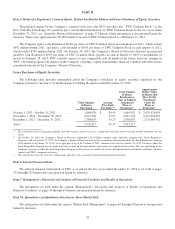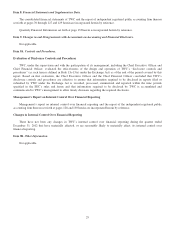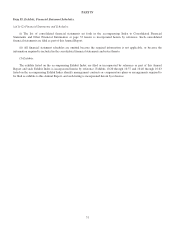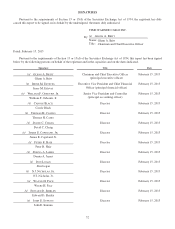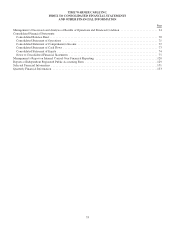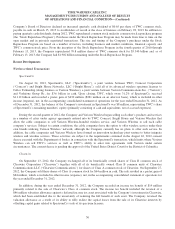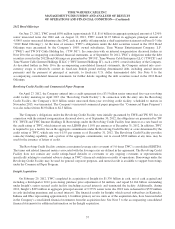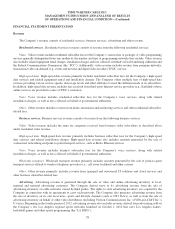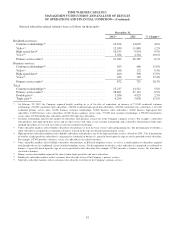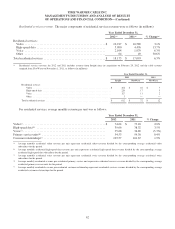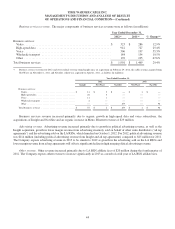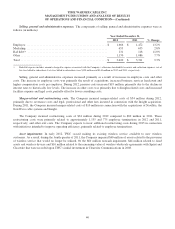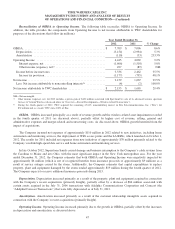Time Warner Cable 2012 Annual Report Download - page 48
Download and view the complete annual report
Please find page 48 of the 2012 Time Warner Cable annual report below. You can navigate through the pages in the report by either clicking on the pages listed below, or by using the keyword search tool below to find specific information within the annual report.TIME WARNER CABLE INC.
MANAGEMENT’S DISCUSSION AND ANALYSIS OF RESULTS
OF OPERATIONS AND FINANCIAL CONDITION—(Continued)
FINANCIAL STATEMENT PRESENTATION
Revenue
The Company’s revenue consists of residential services, business services, advertising and other revenue.
Residential services. Residential services revenue consists of revenue from the following residential services:
Video. Video revenue includes residential subscriber fees for the Company’s various tiers or packages of video programming
services generally distinguished from one another by the number and type of programming networks they include. Video revenue
also includes related equipment rental charges, installation charges and fees collected on behalf of local franchising authorities and
the Federal Communications Commission (the “FCC”). Additionally, video revenue includes revenue from premium networks,
transactional video-on-demand (e.g., events and movies) and digital video recorder (“DVR”) service.
High-speed data. High-speed data revenue primarily includes residential subscriber fees for the Company’s high-speed
data services and related equipment rental and installation charges. The Company offers multiple tiers of high-speed data
services providing various service speeds, data usage levels and other attributes to meet the different needs of its subscribers.
In addition, high-speed data revenue includes fees received from third-party Internet service providers (e.g., Earthlink) whose
online services are provided to some of TWC’s customers.
Voice. Voice revenue includes residential subscriber fees for the Company’s voice services, along with related
installation charges, as well as fees collected on behalf of governmental authorities.
Other. Other revenue includes revenue from home automation and monitoring services and other residential subscriber-
related fees.
Business services. Business services revenue consists of revenue from the following business services:
Video. Video revenue includes the same fee categories received from business video subscribers as described above
under residential video revenue.
High-speed data. High-speed data revenue primarily includes business subscriber fees for the Company’s high-speed
data services and related installation charges. High-speed data revenue also includes amounts generated by the sale of
commercial networking and point-to-point transport services, such as Metro Ethernet services.
Voice. Voice revenue includes business subscriber fees for the Company’s voice services, along with related
installation charges, as well as fees collected on behalf of governmental authorities.
Wholesale transport. Wholesale transport revenue primarily includes amounts generated by the sale of point-to-point
transport services offered to wireless telephone providers (i.e., cell tower backhaul) and other carriers.
Other. Other revenue primarily includes revenue from managed and outsourced IT solutions and cloud services and
other business subscriber-related fees.
Advertising. Advertising revenue is generated through the sale of video and online advertising inventory to local,
regional and national advertising customers. The Company derives most of its advertising revenue from the sale of
advertising inventory on cable networks owned by third parties. The rights to such advertising inventory are acquired by the
Company in connection with its agreements to carry such networks. The Company also generates advertising revenue from
the sale of inventory on its own local news, sports and lifestyle channels (such as NY1 News), as well as from the sale of
advertising inventory on behalf of other video distributors (including Verizon Communications Inc.’s FiOS and AT&T Inc.’s
U-verse). Beginning in the fourth quarter of 2012, advertising revenue also includes revenue derived from advertising sold on
the Company’s two Los Angeles regional sports networks launched on October 1, 2012 that carry Los Angeles Lakers’
basketball games and other sports programming (the “LA RSNs”).
38


